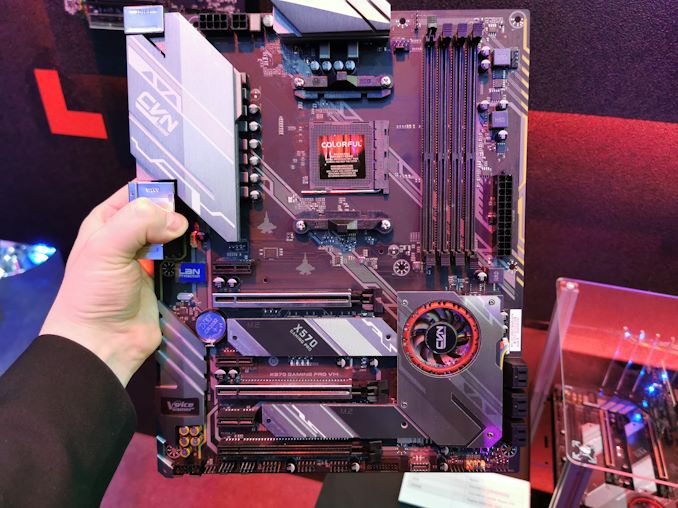The AMD X570 Motherboard Overview: Over 35+ Motherboards Analyzed
by Gavin Bonshor on July 9, 2019 8:00 AM ESTColorful CVN X570 Gaming Pro V14
While not usually a brand found regularly in the western parts of the world, we saw an X570 model from Colorful, or as they are sometimes referred to, iGame. The Colorful CVN X570 Gaming Pro V14 is a little bit of a mouthful to say, but it has a modest feature set onboard with a Realtek Gigabit NIC, two USB 3.1 G2 ports on the rear panel, as well as two PCIe 4.0 M.2 slots. It's aesthetic is quite clean looking with a black and silver design, with a red accented X570 chipset heatsink fan. The CVN series is inspired by militaristic warfare with previous models from iGame taking its design from US Naval aircraft carriers; this is signified by the fighter jet graphics on the boards PCB.
In the top right-hand corner of the board are four memory slots with support for up to DDR4-3466 memory which pails in comparison to the current compatibility from other vendors, even on the cheaper section of the product stack. There are three full-length PCIe 4.0 slots which operate at x16, x8/x8, and x8/x8/x4; this means two-way NVIDIA SLI and up to three-way AMD CrossFire is supported. On top of that are two PCIe 4.0 x1 slots, while sandwiched between these are two PCIe 4.0 x4 M.2 slots, each with its own heatsink attached. Also included are six SATA ports with support for RAID 0, 1 and 10 arrays.
On the rear panel is a single USB 3.1 G2 Type-A, a single USB 3.1 G2 Type-C, four USB 3.1 G1 Type-A and two USB 2.0 ports. Also featured is a HDMI and DisplayPort pairing of video outputs are present which allows users to use the integrated Vega graphics cores of the Ryzen APUs, while the boards six 3.5 mm audio jacks are powered by an ageing Realtek ALC1150 HD audio codec; not seen one of these used for a very long time on a consumer chipset. The CVN X570 Gaming Pro V14's NIC of choice is the Realtek RTL8118AS Gigabit controller which controls the single Ethernet port on the rear panel.
The Colorful CVN X570 Gaming Pro V14 pricing and availability is currently unknown, but we will update once we receive this information. It does feature an interesting controller set, especially the inclusion of an older Realtek ALC1150 HD codec, which would probably make this model one of the cheapest X570 boards around; one would assume. There is support for two-way NVIDIA SLI and the two PCIe 4.0 x4 M.2 slots do include heatsinks but is let down again by the lacklustre memory support (DDR4-3466).












225 Comments
View All Comments
abufrejoval - Tuesday, July 9, 2019 - link
It's amazing how quickly you run out of PCIe lanes, when you don't have switches to multiplex and translate between PCIe revisions and lanes (e.g. PCIe v4 x2 <-> PCIe v2 x8).I find myself using USB 3.x NBase-T NICs and NVMe adapters, simply because they *do* switch.
Bensam123 - Tuesday, July 9, 2019 - link
Maybe a bit more depth on the power delivery page. I have absolutely no idea how to go about parsing what's there. More chokes is better? What denotes a power phase?A5 - Tuesday, July 9, 2019 - link
+1. Some analysis of that information would be helpful.MrSpadge - Tuesday, July 9, 2019 - link
+1bunkle - Wednesday, July 10, 2019 - link
The controller column includes the total number of phases supported split between CPU cores and SoC e.g. (6+1) = 6 CPU phase and 1 SoC phase. More is *usually* better but has diminishing returns regarding tighter and tighter voltage regulation. Some controllers are better than others (can operate at high frequency e.g. 500KHz v 1000KHz, include other features to improve performance) mitigating the need for more phases.Each phase is a buck converter comprised of a low/high side MOSFET (can be integrated in a single package) and choke. Some controllers can support doubling up the PWM signal to driver more MOSFETs. Doublers can also be added as discrete components if not built into the controller.
Current rating of the MOSFET (e.g. Sic639=40A IR3555=60A) indicates the total power deliverable. MOSFETs are not 100% efficient and vary in efficiency. The more current they provide the hotter they get and the less efficient they become, with better MOSFETs producing less heat for a given current. Thus using doubles can improve temperatures and efficiency without the benefits of the tighter voltage tolerance that *real* phases provide.
Hope that’s helpful!
bunkle - Wednesday, July 10, 2019 - link
A lot more detailed explanation: https://en.wikichip.org/wiki/voltage_regulator_mod...bug77 - Tuesday, July 9, 2019 - link
The description for AsRock X570(M) Pro4 says "5 jack + 1 SPDIF". Unfortunately, those boards lack SPDIF and only come with 3 jacks ;)Smell This - Tuesday, July 9, 2019 - link
I'm thinking the *ASRock Thunderbolt AIC* ...https://thunderbolttechnology.net/product/asrock-t...
would cover all your TBT peripheral needs, including optical.
DanNeely - Tuesday, July 9, 2019 - link
Do X570 boards still need an extra chip per USB port to support USB-C reversibility?The additional expense and needed PCB space were cited as among the reasons why earlier generation boards (IIRC both Intel and AMD) almost never had more than 1 C port; but it was never clear to me if that was an inherent implementation penalty for the C port or an artifact of Intel's tech stack being stalled out and AMD outsourcing to ASMedia which built the chipsets on an ancient (55nm) platform.
DigitalFreak - Tuesday, July 9, 2019 - link
Gavin - X370 and X470 only supported PCIe 2.0. The connection between the CPU and chipset was 3.0, but all the ports on the chipset were 2.0.